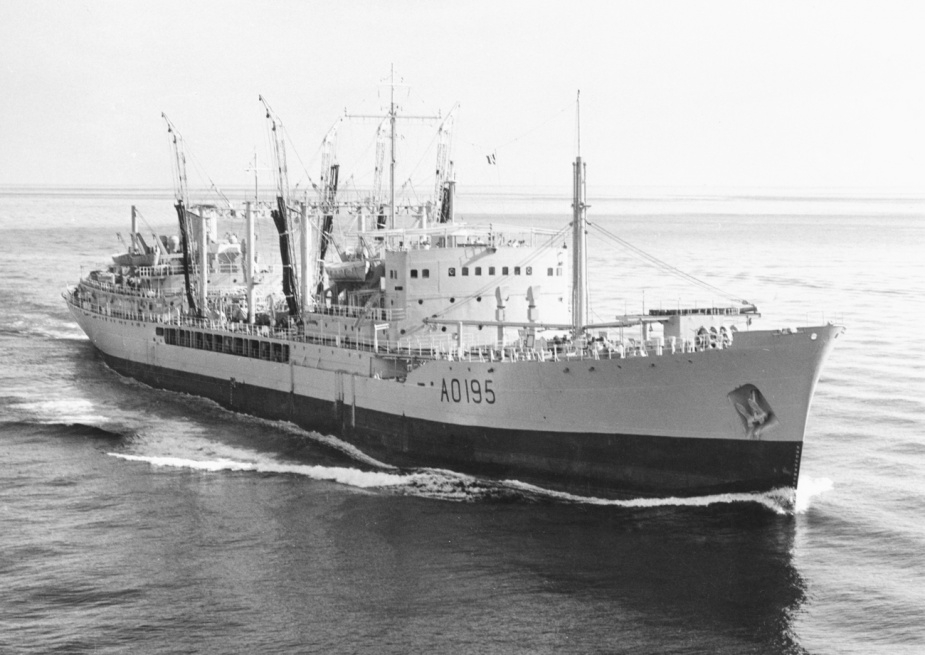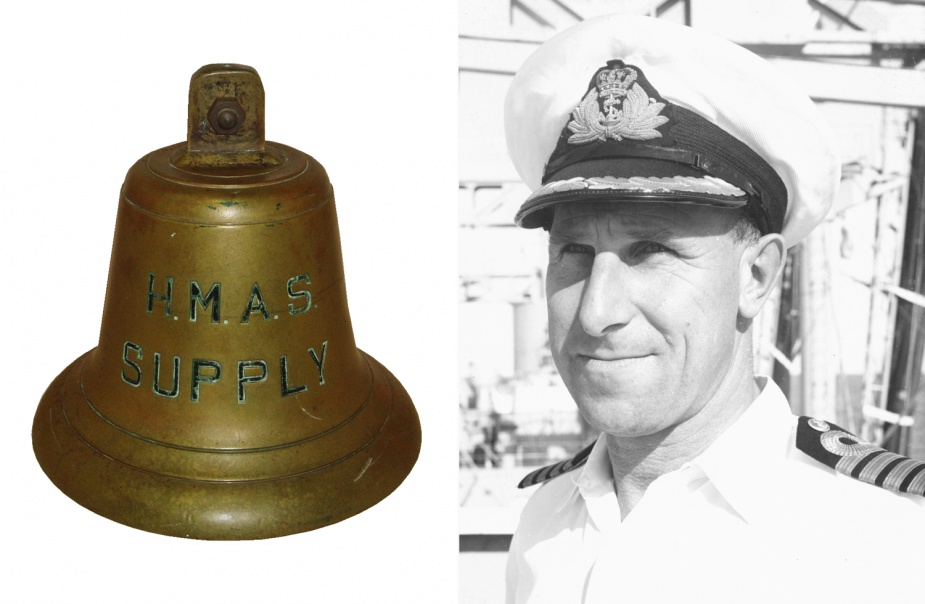HMAS Supply (I)
| Type |
Tide Class Fleet Tanker |
|---|---|
| Pennant |
0195, A195, AO195 |
| International Callsign |
VKCX |
| Motto |
Strengthen the Shield |
| Builder |
Harland & Wolff Ltd, Belfast |
| Laid Down |
5 August 1952 |
| Launched |
1 September 1954 |
| Launched by |
Mrs Foley, wife of Captain JB Foley, RAN, the liaison officer for the RAN in the United Kingdom |
| Commissioned |
15 August 1962 as HMAS Tide Austral |
| Decommissioned |
16 December 1985 |
| Dimensions & Displacement | |
| Displacement | 25,941 tons |
| Length | 583 feet 1 7/8 inch |
| Beam | 71 feet 3 3/4 inches |
| Draught | 32 feet 1 inch |
| Performance | |
| Speed | 17.5 knots |
| Complement | |
| Crew | 205 |
| Capacity | 17,957 tons Oil and Spirit |
| Propulsion | |
| Machinery | Single screw gear turbines |
| Horsepower | 15,000 |
| Armament | |
| Guns |
|

The ship that would serve in the Royal Australian Navy (RAN) as HMAS Supply (I) was built by Harland & Wolf Ltd, Belfast, Northern Ireland. She was ordered as a war operations measure for the RAN as a result of a Government direction in 1951 requiring the armed services to prepare for mobilisation by 1953. Her keel was laid on 5 August 1952 and she was launched on 1 September 1954 by Mrs Foley, wife of Captain JB Foley, RAN, the Liaison Officer for the RAN in the United Kingdom. A bottle of Australian wine was used to christen the vessel Tide Austral.
The subsequent easing of international tensions rendered her employment as a unit of the RAN unnecessary at the time of her completion in March 1955 and she was subsequently leased to the British Admiralty which operated her as a Royal Fleet Auxiliary (RFA) between 1955 and 1962.
In 1962 the Australian Naval Board decided to add Tide Austral to the Australian Fleet and she commissioned in the RAN at Southampton on 15 August 1962 under the command of Captain GV Gladstone, DSC*, RAN.
HMAS Tide Austral only enjoyed a brief time as a commissioned ship of the RAN for on 7 September 1962 the ship was renamed HMAS Supply by Mrs Becher, wife of Rear Admiral Otto H Becher, CBE, DSO, DSC*, RAN. The name Supply was selected to commemorate the ship of the same name that accompanied the First Fleet to Sydney in 1788.
To ready Supply for her voyage to Australia several contingents of RAN personnel were flown to the UK to learn how to operate the tanker and acquaint themselves with the vessel. Following a brief period of workups, Supply sailed from Portsmouth on 1 October 1962 bound for Sydney where she arrived on 6 December in time for Christmas.
As a unit of the RAN fleet, Supply’s role was to replenish other naval vessels at sea, thus giving the Fleet far greater range, mobility and flexibility. Replenishments at sea, or ‘RAS’ as they are known, are carried out almost anywhere at sea, day and night and in a wide range of weather conditions while ships are underway. The particular role of Supply was to provide fuel, aviation gasoline, diesoline and water to fleet units.
Throughout the 1960s and early 1970s Supply participated in a broad range of Commonwealth and SEATO exercises during which time she visited numerous South East Asian ports. These visits proved popular with her crew following many weeks at sea exercising and on passage.
In 1969, in a first for an RAN replenishment ship, Supply was awarded the prestigious Duke of Gloucester's Cup for being deemed the RAN unit displaying the highest level of overall proficiency.
On 25 June 1973 Supply sailed from Sydney having received orders to support HMNZS Otago on a protest mission to observe French nuclear atmospheric tests taking place at Mururoa Atoll in the South Pacific. The two ships rendezvoused on 29 June when Otago was received alongside Supply for the first of several replenishment serials in connection with the operation. Later HMNZS Canterbury joined the protest action and she too was supported by Supply. Further details, and an expression of thanks to the crew of Supply from the New Zealand government, may be found in the 14 September 1973 edition of Navy News.
During her long and diverse career, Supply visited the African continent, took part in the American bicentenary celebrations in 1976, visiting Hawaii the US mainland and Canada and was one of the many RAN ships that steamed at short notice to Darwin in the wake of Tropical Cyclone Tracy on Boxing Day 1974. http://seapower.navy.gov.au/history/videos/operation-navy-help
As part of the Darwin relief operation she was loaded with generators, tents, medical supplies and building repair stores to assist the cyclone-stricken city. Many of her crew forged long lasting friendships with those they helped in Darwin.

By the 1980s Supply was fast approaching the end of her useful life and although she was tired and old, those who served in her did so with and enduring affection for their ship.
By 1985 a decision had been made to decommission Supply to make way for the new fast underway replenishment ship HMAS Success which was nearing completion at Cockatoo Island Dockyard in Sydney.
During her career Supply steamed 667,421 miles at an average speed of 12.84 knots and completed 3401 underway replenishments at sea. Her sea time ended on 11 November 1985, Remembrance Day, when she entered Port Jackson, Sydney for the last time. She decommissioned on 16 December 1985.


















